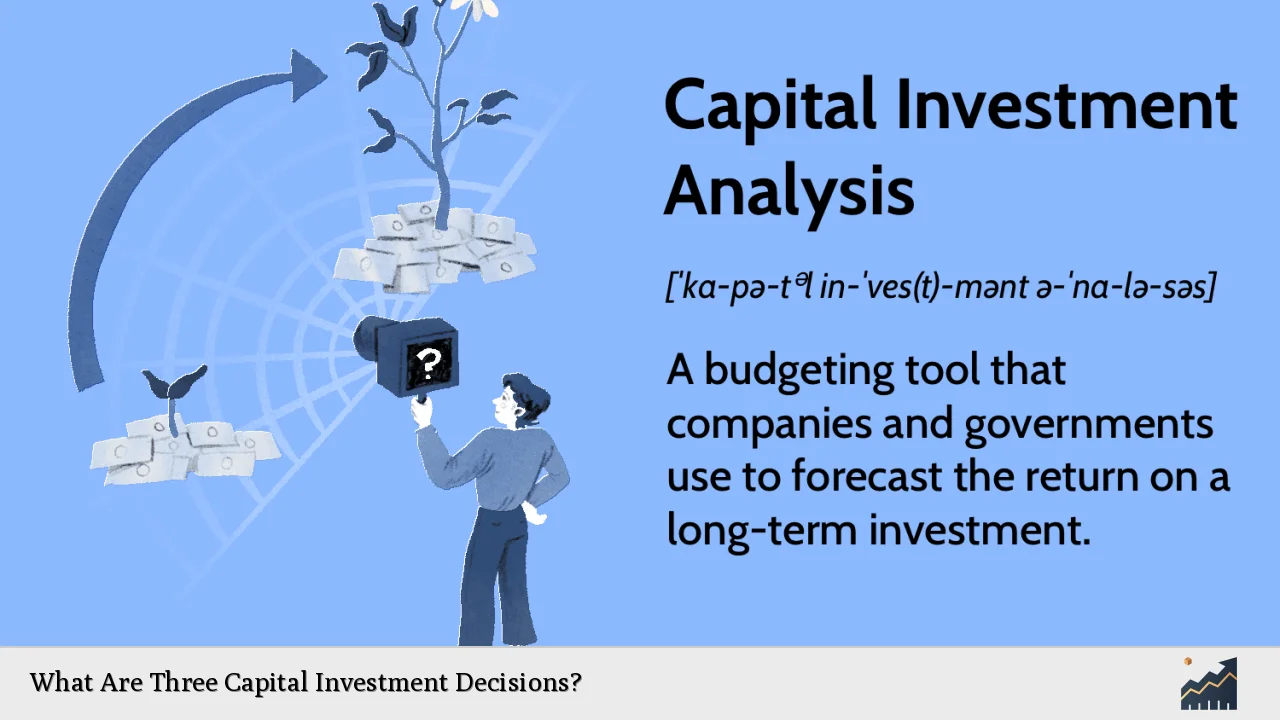Capital investment decisions are crucial for any business aiming to secure its financial future and enhance growth. These decisions involve the allocation of significant resources to projects that are expected to yield returns over time. The complexity of these decisions arises from the need to evaluate potential risks, returns, and alignment with strategic business goals. This article will explore three primary types of capital investment decisions: investing in new equipment or machinery, expanding into new markets or geographic areas, and acquiring or merging with another company.
| Capital Investment Decision | Description |
|---|---|
| Investing in New Equipment | Purchasing machinery or technology to improve production efficiency. |
| Market Expansion | Entering new geographic markets to increase customer base and sales. |
| Mergers and Acquisitions | Combining with or purchasing another company to enhance market position. |
Investing in New Equipment
Investing in new equipment is a fundamental capital investment decision that can significantly impact a company's productivity and efficiency. This decision often involves evaluating various types of machinery or technology that can streamline operations, reduce costs, and improve product quality.
When considering this investment, businesses must conduct a thorough analysis of the expected return on investment (ROI). This involves estimating how much additional revenue the new equipment will generate compared to its cost. For instance, a manufacturing company may consider upgrading its assembly line with automated machinery that promises faster production rates and lower labor costs.
Another critical factor is the payback period, which measures how long it will take for the investment to pay for itself through increased revenues or cost savings. A shorter payback period is generally preferred as it reduces risk and allows for quicker reinvestment of funds into other projects.
Additionally, companies must assess the impact on operational flexibility. New equipment should not only meet current production needs but also allow for scalability as demand grows. This means choosing equipment that can be upgraded or expanded without requiring a complete overhaul.
Expanding into New Markets
Expanding into new markets is another vital capital investment decision that can drive growth and increase a company's market share. This decision typically involves entering new geographic regions or demographic segments where there is potential demand for the company's products or services.
Before making this investment, businesses should conduct comprehensive market research to understand consumer behavior, competition, and economic conditions in the target area. This research helps identify whether the potential rewards justify the risks involved in entering a new market.
Strategic alignment is also crucial when considering market expansion. The investment should align with the overall business strategy, ensuring that it supports long-term goals such as brand recognition, customer loyalty, and operational efficiency. For example, a company known for its eco-friendly products might target regions with a strong demand for sustainable goods.
Moreover, companies need to evaluate their financial resources and determine how they will fund this expansion. Options may include using retained earnings, securing loans, or attracting investors. Each option carries different implications for cash flow and ownership structure.
Mergers and Acquisitions
Mergers and acquisitions (M&A) represent one of the most significant capital investment decisions a company can make. This strategy involves combining with another company or purchasing it outright to enhance market presence, reduce competition, or achieve synergies in operations.
The decision to pursue M&A requires a detailed due diligence process, where companies assess the financial health, market position, and operational capabilities of potential targets. This analysis helps identify whether the acquisition will create value through cost savings or revenue enhancements.
Another critical aspect is understanding the cultural fit between merging organizations. Successful mergers often depend on how well the two companies can integrate their operations, cultures, and management styles. Poor cultural alignment can lead to employee dissatisfaction and high turnover rates post-merger.
Furthermore, companies must consider the financing structure of an acquisition. Whether opting for debt financing or issuing equity shares, each method has implications for financial stability and shareholder value. It is essential to balance these factors carefully to ensure that the merger enhances overall business performance without over-leveraging.
FAQs About Capital Investment Decisions
- What are capital investment decisions?
These are choices made by businesses regarding where to allocate significant resources for long-term benefits. - Why is investing in new equipment important?
It enhances productivity and efficiency while potentially reducing operational costs. - What factors influence market expansion decisions?
Market research, strategic alignment, and financial resources are key considerations. - How do mergers and acquisitions create value?
They can enhance market position through synergies in operations and reduced competition. - What should companies assess before making capital investments?
Companies should evaluate expected ROI, payback periods, risks involved, and alignment with strategic goals.
In conclusion, capital investment decisions are pivotal in shaping a company's future trajectory. By carefully evaluating investments in new equipment, market expansions, and mergers or acquisitions, businesses can position themselves for sustained growth and competitive advantage. Each decision requires thorough analysis and strategic planning to ensure that resources are allocated effectively towards initiatives that will yield substantial returns over time.

